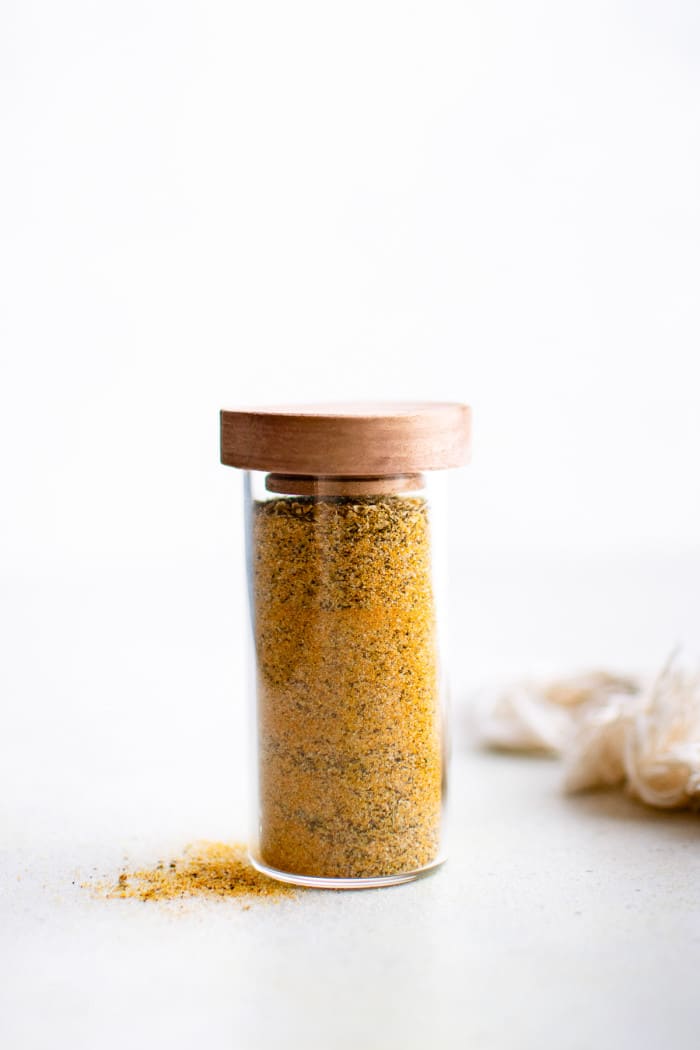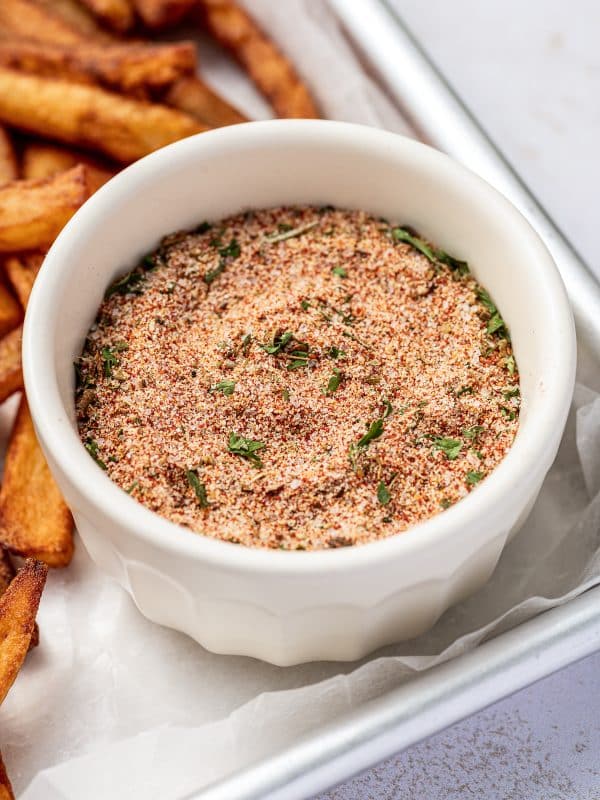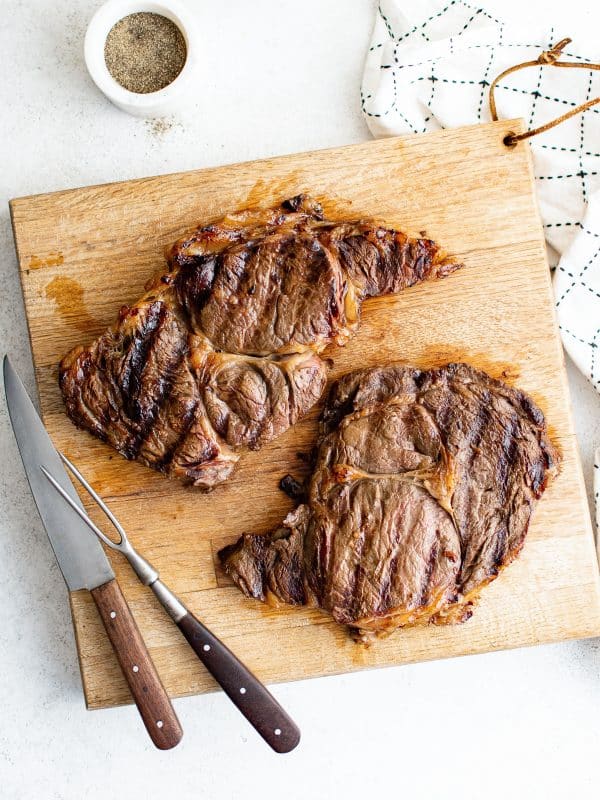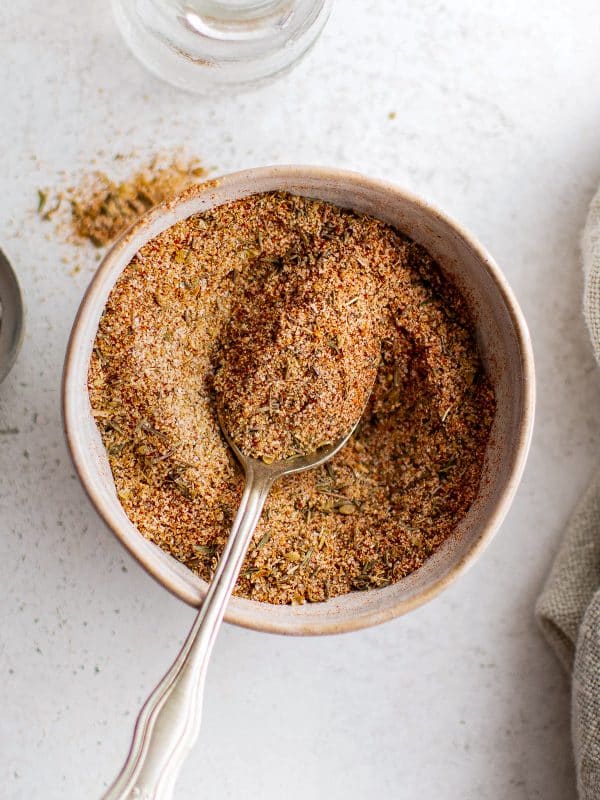This post may contain affiliate links. See my disclosure policy.
Adobo Seasoning is a popular, all-purpose Caribbean and Latin American seasoning blend. In this recipe, we’re ditching the additives and MSG found in some store-bought brands for a homemade blend made with just 5 pantry ingredients. Variations included.

Adobo Seasoning Recipe
Today we’re making another homemade seasoning blend to add to our collection. Making homemade spice blends is not only budget-friendly, but it allows you to know exactly what’s being added (and what isn’t). Many store bought brands are packed with chemicals, fillers, artificial colors and flavors (like monosodium glutamate). The ever-popular Goya adobo seasoning is especially confusing since it comes in at least nine different varieties, some with MSG and additives, and others without. So, just like my homemade sazón seasoning and sofrito recipe, I’ve found it much easier to make my own.
At the very least, you can use this recipe as an adobo seasoning substitute should you ever run out of your favorite store-bought variety.
Table of Contents
What is Adobo Seasoning?
Adobo seasoning is a versatile all-purpose spice blend widely used in Latin American and Caribbean cooking—especially in Puerto Rican, Dominican, and some Mexican cuisines. It is used in the same way you’d use an all-purpose seasoning salt. Sprinkle it on meat before grilling, mix it into marinades and sauces, or add it to vegetables, beans, and rice.
The history of adobo seasoning is a bit interesting for anyone curious (otherwise, feel free to skip to the next section).
Basically, the concept of adobo was introduced to colonies in Latin America by Spanish colonizers. The word “adobo” comes from the Spanish verb “adobar,” meaning to marinate or season. In Spain, this referred to a way of preserving meat using vinegar, salt, and spices before the days of refrigeration. Over time, particularly in Puerto Rico and the Dominican Republic, adobo evolved evolved into a dry seasoning blend and became a go-to all-purpose seasoning for meats, beans, rice, and vegetables.
Adobo in other cuisines:
In the Philippines, the term “adobo” refers to a “wet marinade” cooking method where meat is simmered in vinegar, soy sauce, garlic, and bay leaves. Although the name is Spanish, Filipino adobo developed independently of the Latin American spice blend.
There are also canned chipotles in adobo sauce. Made with canned whole chilies in a thick, spicy, smoky adobo sauce, this type of adobo is most commonly associated with Mexican recipes like chicken tinga. Just like Filipino adobo, there is not correlation between canned chipotle chiles in adobo and the dry Latin American spice blend.
Ingredients in Adobo Seasoning
Adobo seasoning is typically made with salt, garlic powder, dried oregano, and black pepper. The exact mix can vary—some blends contain turmeric or ground annatto (for color), cayenne (for heat), dried citrus (for freshness), or cumin (for warmth).
This homemade adobo recipe is made with salt, garlic powder, oregano, turmeric, and ground black pepper.

Flavor Variations
Tip: Grind the ground lemon peel or orange peel until it is the same consistency and size as the garlic powder. You can do this in a mortar and pestle or in a spice grinder.
- Onion Powder – add 2-4 teaspoons
- Ground Cumin – add 1/2-1 teaspoon
- Cayenne Powder – add 1/4-1 teaspoon
- Ground Lemon Peel – add 1 teaspoon
- Ground Orange Peel – add 1 teaspoon
- Smoked Paprika – add 1-2 teaspoons
Adobo Seasoning Uses
Adobo seasoning is an a super versatile, multi-purpose blend and one of my favorite substitutes for salt. It’s a kitchen staple throughout the Caribbean and Latin America, but especially so in Puerto Rico where it’s a must-have ingredient in dishes like Arroz con Gandules and Pollo Guisado (Puerto-Rican Chicken Stew).
But, adobo seasoning isn’t just for Puerto Rican cuisine. You can use it on just about any savory dish. It’s an incredible dry rub for most cuts of meat from flank steak and pork shoulder, to chicken and fish. You can add it rice and beans, use it to season garlic roasted potatoes, or sprinkle it over your next buttered corn on the cob.
It also makes a fantastic wet marinade. You’ll need about 2 tablespoons of adobo seasoning, 2-3 tablespoons of olive oil, 1-2 tablespoons of an acid like lime juice, vinegar, or orange juice, and fresh garlic (optional). Marinate chicken, beef, or pork for at least an hour, or seafood for up to 30 minutes.


Frequently Asked Questions
The general idea is that adobo is the Latin American equivalent of all-purpose seasoning salt. It’s used as a seasoning base. It’s salty, herbaceous, and garlicky. Sazón seasoning, on the other hand, is a flavor booster often added during cooking and in smaller amounts. It is earthy, peppery, and typically includes annatto (which imparts a beautiful red hue wherever it’s added). While they are frequently used together, they are not interchangeable.
Not usually. Most store-bought adobo seasoning blends are mild unless otherwise stated. This recipe is very mild. You can make it spicy on purpose– just add a pinch or two of cayenne powder or chili powder.
Looking for more additive-free homemade seasoning blends? Try my Homemade Shake and Bake Seasoning Recipe, this Homemade Ranch Seasoning, and my Homemade Taco Seasoning Recipe.

Adobo Seasoning
Ingredients
- 3 tablespoon fine sea salt, see notes
- 3 tablespoon garlic powder
- 2 teaspoon ground black pepper
- 2 teaspoon turmeric
- 2 teaspoon ground oregano
Instructions
- Combine all of the ingredients in a medium bowl or jar until completely combined. Use a funnel to transfer the homemade seasoning to an airtight jar or container.
Notes
- Rice: 2 teaspoons per 1 cup dry rice
- Beans: ½-1 teaspoon per 15-ounce can or 1½ cups cooked
- Meats: 2 teaspoons per 1-pound of meat
Nutrition
Nutrition information is automatically calculated, so should only be used as an approximation.















This seasoning is just like I remember! So good on pork!!
Thanks Kat, I also love this on any pork 🙂